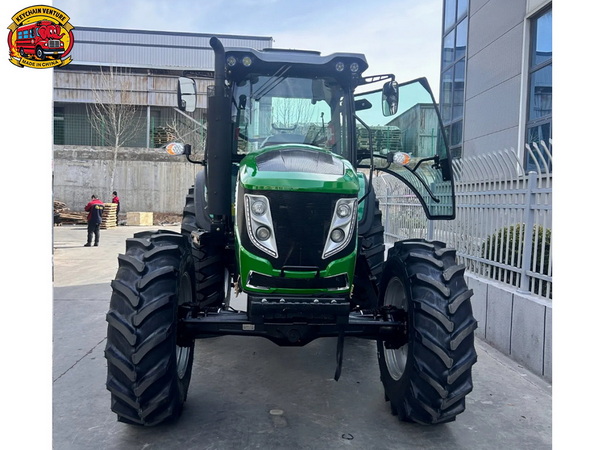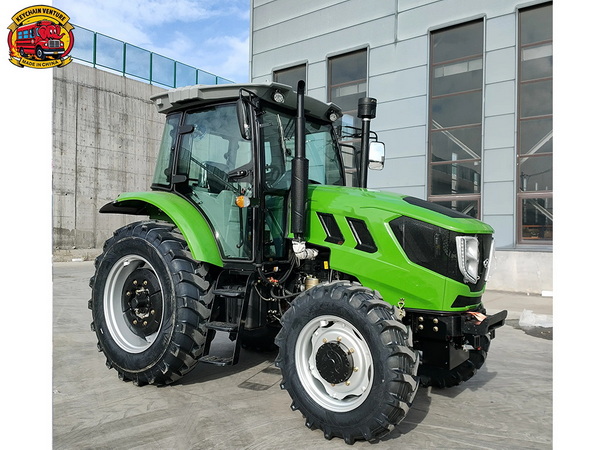Views: 222 Author: Amanda Publish Time: 2025-10-30 Origin: Site








Content Menu
● The Role of Tractor Batteries
● Typical Lifespan of Tractor Batteries
● Major Factors Influencing Battery Life
>> Charging System Performance
● Warning Signs and Replacement Indicators
>> Monthly Maintenance Checklist
>> Seasonal Maintenance and Storage
● Battery Replacement: Step-by-Step
● Pro Tips to Extend Battery Performance
● Tractor Battery Use Cases and Trends
● FAQ
>> 1. What battery type lasts the longest in tractors?
>> 2. How often should tractor batteries be checked and cleaned?
>> 3. Why are batteries more likely to fail in winter?
>> 4. Can tractor batteries be recharged if deeply discharged?
>> 5. What's the best way to store tractor batteries during off-season?
Tractor batteries are fundamental for the reliable operation of farm machinery, commercial vehicles, and construction equipment. Their longevity depends largely on the type of battery, frequency of use, maintenance practices, and environmental factors. For businesses such as KeyChain Venture Co., Ltd., understanding battery health and replacement cycles is crucial for maximizing fleet uptime and minimizing unforeseen breakdowns.[11][12]

Tractor batteries supply power for engine ignition, onboard electronics, and auxiliary systems. Whether used in agricultural tractors, heavy trucks, or specialty machinery, a dependable battery keeps equipment running efficiently throughout busy seasons.[12][13]
Tractor batteries are available in a range of types:
- Flooded Lead-Acid: The most common, affordable, but requires periodic maintenance.[6][13]
- AGM (Absorbent Glass Mat): Maintenance-free, vibration-resistant, preferred for rough terrain.[13]
- Gel Cell: Sealed, versatile, less sensitive to temperature fluctuations.[13]
- Lithium-Ion: Lightweight, long-lasting, ideal for modern and electric tractors.[13]
- Deep Cycle: Designed for heavy electrical loads or frequent discharging.[12]
Proper battery selection ensures adequate cold cranking amps (CCA) for the tractor's climate and operational needs.
Tractor batteries generally last between 3 to 8 years, depending on the battery type and environmental stressors. Lead-acid varieties offer dependable service for about 3–5 years, while AGM and lithium-ion models can reach 10 years with diligent maintenance.[1][6][11][12][13]
Longevity can be extended by:
- Regular maintenance and cleaning.[3][1]
- Ensuring correct charging cycles.[9][12]
- Avoiding extremes of temperature and vibration.[14][12]
- Reducing unnecessary electric loads during idle periods.[3]
Premium batteries—AGM, lithium-ion—are engineered for longer life and greater durability. Lower-cost batteries offer shorter service spans and require more frequent maintenance.[6][13]
Frequent use allows batteries to stay charged and avoids deep discharges. Sporadic or seasonal use may lead to battery drain and sulfation, especially if left unattended for months.[9][3]
Routine maintenance is essential:
- Clean terminals and cable connections with baking soda solution or a wire brush.[5][1][3]
- Apply a corrosion inhibitor or petroleum jelly to terminals.[3][6]
- Check electrolyte level for flooded batteries and add distilled water as needed.[1][5][6]
- Tighten all terminal connections and inspect casing for leaks or cracks.[5][1][3]
Extreme weather, especially severe cold or heat, degrades battery chemicals and leads to early failure. Vibration from rough terrain can damage internal plates if batteries aren't properly secured.[14][12][13]
Proper alternator and voltage regulator function ensures batteries receive adequate charge without overcharging, overheating, or deep discharging. Use a smart charger for off-season storage to maintain optimal charge.[10][1][12][3]
Early identification of battery issues prevents breakdowns:
- Slow engine cranking or clicking noises at start.[15][11][12]
- Frequent need for jump-starts, especially during colder months.[11][12]
- Dimming lights or erratic electronic behavior.[11][12]
- Visible corrosion, swelling, leaks, acid residue on or around the battery.[1][6]
- Battery age exceeding manufacturer's recommendation (often 5+ years).[1]
- Voltage below normal levels, even after charging (healthy battery: 12.6–12.8V off, 13.5–14.5V running).[9][1]
Replace batteries proactively if any of these symptoms persist.

- Inspect battery and terminals for rust, swelling, or damage.[5][6]
- Clean terminals using a baking soda and water solution, then dry thoroughly.[5][1]
- Coat terminals with protective grease to minimize corrosion.[6]
- Check electrolyte levels and add distilled water as needed for flooded batteries.[6][1]
- Tighten all connections to avoid unwanted discharge.[5]
- Ensure battery is fully charged when not in active use; use a trickle or smart charger for prolonged idle periods.[10][3]
- Store battery in a cool, dry place (ideally 15–25°C).[5]
During off-seasons, remove batteries from tractors and store them on wooden surfaces to prevent ground discharge. Avoid direct contact with concrete floors. Periodically recharge stored batteries and inspect for degradation before reinstallation.[7][10][3]
- Always follow manufacturer instructions for your charger and battery type.[3][9]
- Avoid overcharging (can lead to swelling and leaks).[1]
- Monitor charge status frequently, especially before seasonal use.[6]
- If using maintenance-free batteries, check indicator codes for green (charging), black (needs recharge), or white (replace).[6]
- Always wear gloves and goggles when dealing with batteries.[3]
- Handle with care, especially if acid leaks or swelling are detected.
- Recycle old batteries according to local regulations, never dispose in regular waste.[5]
1. Turn off tractor and remove ignition key.[1][5]
2. Disconnect negative (black) terminal first, then positive (red).[1][5]
3. Remove old battery; ask for assistance due to weight.[5]
4. Clean compartment and terminals thoroughly before installing new battery.[5]
5. Insert new battery securely, reconnect positive then negative cables.[1][5]
6. Test tractor starting and all electrical systems; adjust connections if needed.[1][5]
7. Recycle the old battery responsibly.[5]
- Use a battery cut-off switch in wet conditions or if tractor will sit idle for long periods.[6]
- Apply petroleum jelly to cleaned terminals for corrosion resistance.[3][6]
- Avoid adding tap water to lead-acid batteries—only distilled water preserves longevity.[6][1]
- Charge batteries after every use during harvesting or busy season.
- Maintain records of purchase date and maintenance to anticipate replacement needs.
Modern tractors increasingly rely on AGM and lithium-ion batteries due to onboard electronics, GPS, and fleet management systems. For commercial applications, investment in durable, vibration-resistant batteries reduces operational downtime for heavy-duty trucks and passenger buses alike. The Asia-Pacific market is seeing rapid adoption of maintenance-free battery types due to expanding fleets and the need for reliability in variable climates.[16][13]
Fleet managers at major commercial vehicle suppliers invest in proactive battery replacements and scheduled maintenance to keep equipment operational during peak season, ensuring maximum ROI and minimum disruption.
Tractor batteries play a critical role in the day-to-day operations of commercial vehicles and farm equipment. Their life expectancy ranges from three to eight years depending on battery type, usage, maintenance practices, and environmental exposure. Consistent inspection, cleaning, smart charging, and climate-aware storage will maximize reliability and minimize costly downtime. Recognizing early failure symptoms allows proactive replacement, protecting investment and ensuring agricultural and logistical operations run smoothly.[12][11][6][1]

AGM and lithium-ion batteries offer the longest service life due to advanced construction and resistance to vibration and corrosion.[13][6]
Inspect and clean terminals at least once a month, or more often in harsh environments or high-use scenarios.[6][1][5]
Cold weather slows chemical reactions, drops starter power, and accentuates underlying battery weaknesses, leading to increased failure rates.[14][12][1]
Recharge is possible for some batteries but may reduce long-term capacity and lifespan. Repeated deep discharges cause internal damage in lead-acid types.[9][12][1]
Remove the battery, store it in a dry, cool place off concrete, keep charge topped up, and periodically inspect for damage or voltage drop.[3][6][5]
[1](https://www.mahindratractor.com/blog/tractor-battery-maintenance-replacement-tips)
[2](https://www.facebook.com/groups/6664286290366735/posts/9232335170228488/)
[3](https://www.teamtractor.com/blog/i-want-to-properly-maintain-my-tractor-battery--61541)
[4](https://www.swbatteries.com.au/maintenance-of-tractor-battery/)
[5](https://ajcbattery.com/resources/tractor-mower-replacement-battery-guide/)
[6](https://tractorkarvan.com/blog/tips-to-keep-your-tractor-battery-healthy)
[7](https://www.partsasap.com/blog/post/tractor-tune-up-guide-the-battery-part-5)
[8](https://www.kenotractors.com/tractor-blog/tractor-battery-guide/)
[9](https://www.tractorjunction.com/tractor-news/tractor-battery-maintenance-tricks-to-extend-battery-life/)
[10](https://hobbytractors.com/how-to-maintain-a-battery/)
[11](https://www.continentalbattery.com/blog/how-long-do-tractor-batteries-last)
[12](https://www.tycorunenergy.com/how-long-do-tractor-batteries-last/)
[13](https://www.tycorunenergy.com/what-batteries-do-tractor-use/)
[14](https://manlybattery.com/how-long-does-a-tractor-battery-last/)
[15](https://tonystractors.com/tractor-battery-replacement-guide-keep-your-machine-running-smoothly.htm)
[16](https://12-volt-tractor-battery.pages.dev/posts/12-volt-tractor-battery/)
[17](https://www.youtube.com/watch?v=NQtrg4I3vUM)
[18](https://www.youtube.com/watch?v=FHXvJDZvZ_o)
[19](https://www.youtube.com/watch?v=3iRgyY05Je0)
[20](https://tym.world/en-us/all-how-tos-checklists/how-to-check-charge-and-replace-the-battery)
[21](https://www.youtube.com/watch?v=yg1_c9vqpkk)